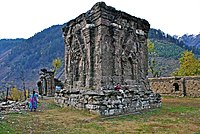User:Weichan123/sandbox3
| Songsarek | |
|---|---|
| Type | Traditional religion |
| Language | Garo |
Songsarek is the indigenous religion practiced by the Garo people of Meghalaya, India. It is the traditional religion of the Garo people and was practised historically by majority of the Garo people. Currently a minority of the Garo people follows the religion. [1]
History
[edit]Songsarek was followed by majority of the Garo people historically. By the spread of Christianity in the Garo hills in the second half of the nineteenth century and throughout the twentieth century, the proportion of Songsarek population decreased.[2]
Beliefs
[edit]The Supreme God in Songsarek religion is the Tatara Rabuga, described in oral tradition as "one so high that he cannot be reached." His deputy is, Misi Saljong, who is the God of Sun, crops and fertility and is worshipped in Wangala festival. Susime is the Goddess of wealth. During the Wangala festival, women wear skirts crafted from handwoven cloth made on looms. These skirts feature a traditional pattern resembling a diamond, symbolizing the eye of Susime, the Goddess of Wealth.[2][3]
The Rokkime is the Mother Goddess of Rice and is worshipped in the Agalmaka festival.[4]
The Wagtail bird holds significant importance in Songsarek beliefs. Villagers carefully observe its flight patterns to predict the rainfall for the season.[2]
Demographics
[edit]The number of the Songsarek followers in Meghalaya has declined from more than 88,000 as per 1991 Census to about 17,000 in 2011 Census. It was followed by 16% of the Garo in 1991 and decreased to 2% in 2011.[5]
In the Garo hills, currently only 13 to 15 villages out of the 150 villages are Songsarek majority villages.[2]
In Bangladesh, 3.71% of the Garo people follows Songsarek[6]
Festivals
[edit]
Wangala is the harvest festival of Songsarek followers. During the festival, handprints using three fingers dipped in rice flour are created on their doors. These imprints symbolize the water level and are meant to ensure a good harvest.[2] During the festival, the first harvest is offered to Misi Saljong, the Sun God and giver of life, in a ritual known as Rugala.[3]
Agalmaka is an another festival in which the Misi Saljong and Rokkime, the mother goddess of Rice is worshipped.[4]
Recognition
[edit]Niamtre is not recognised as a minority religion by the state or central government. The niamtre followers have been demanding it.[7]
See also
[edit]References
[edit]- ^ Paulinus R. Marak: The Garo tribal religion: beliefs and practices (Delhi: Anshah Pub. House, 2005) ISBN 8183640028
- ^ a b c d e Pioneer, The. "Vibing to the dance of a 100 drums". The Pioneer. Retrieved 2024-12-07.
- ^ a b "The Hundred Drums Wangala". The Hindu. 2012-11-24. ISSN 0971-751X. Retrieved 2024-12-07.
- ^ a b "Garo festival Agalmaka to be held at Chibagre today | Highland Post". 2021-03-09. Retrieved 2024-12-07.
- ^ "Religion Data of Census 2011: XXX ST Meghalaya". Retrieved 2024-12-07.
- ^ Chakma, Sheeladitya. "A CASE STUDY ON THE GARO ETHNIC PEOPLE OF THE SAL (Shorea robusta) FORESTS IN BANGLADESH".
- ^ Rashir, Princess Giri (2022-05-25). "Meghalaya: HYC wants Centre to notify Khasi indigenous faith as minority". EastMojo. Retrieved 2024-12-07.

